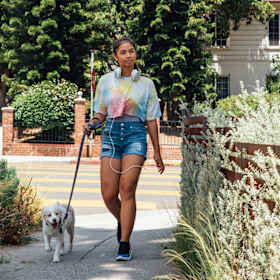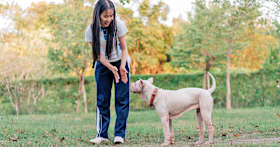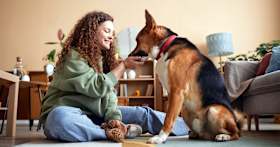So You’re Bringing Home a Rescue Dog—Here’s What to Do
New rescue dog? Don’t panic — here’s your survival guide for the first few days and how to connect with your new best friend.
New rescue dog? Don’t panic — here’s your survival guide for the first few days and how to connect with your new best friend.
by Nisha Gopalan, | January 1, 2025

Lisa Weatherbee / Adobe Stock
Once you finally found your furry soulmate, you probably felt an incredible sense of relief. As you should: You just saved a life, and your rescue dog could very well be saving yours, too. But once you bring home a rescue (especially if this is your first dog), reality kicks in, and you may be secretly wondering, “Holy crap, what have I done?”
Turns out that initial shock is very common and won’t last forever. Introducing a new dog to your home can be trickier than all those cute TikTok videos may imply. But with some calm perseverance, you’ll see your dog’s personality shine through over time as they begin to understand you’re their pet parent.
While you wait for that big reveal, the guide below can help you know what to expect and how to navigate any uncertain times with your new dog.
Before bringing a new dog home, make sure you have all the supplies you need, from bedding and food to a leash and collar. (This new pet checklist is helpful on that front.) Also, do not forget to dog-proof your home. This entails removing certain items that could come in contact with your dog, such as toxic plants and chemicals, items prone to falling, and any precious belongings you’d rather not have chewed up.
“It will also be good to do a walk-through and see if there are any parts of your home or yard where the dog may escape,” certified dog trainer Paula Ferrel CPDT-KA, CBCC-KA, CSB-D, who works with the nonprofit Pasadena Humane Society, says. “Not that they will intentionally be trying to, but some dogs are opportunists.”
Bringing home a new rescue dog is exciting, but the first moments are crucial. While it’s great to be prepared, remember your new dog may have preferences of their own. If things don’t go as planned — be ready to adjust. Here’s what you should do right after adoption to help them settle in and feel safe. Maintain a good sense of humor and try not to get exasperated. The transition period won’t last forever.
Show your new pup around the home and introduce them to a safe, quiet place inside where they can decompress. Then, let them off-leash to relax in their safe space (which could be a room, a bed, or a crate). “Avoid having people over. Many times, we get excited and call up our friends and family members to come check out our new family member,” Ferrel cautions. “This can be overwhelming for a new pet. Keep it simple and closed to those who live in the home.” (She also recommends reading the books Doggie Language and Canine Enrichment for the Real World.)
Follow your pup’s cues. Do not force them to play, be pet, or cuddle. A rescue may have been abused, abandoned, and/or seen many homes, shelters, and fosters in their life, so it’s understandable if they seem a bit withdrawn or nervous about being moved to yet another setting. You may also notice signs of anxiety, such as a lack of appetite, suppressed bowel habits, hiding under furniture, or staying in one room for a few days — this is normal behavior. This behavior will ease up over time.
Feed them and take them on a few short walks (or out to your yard) in case they need to relieve themselves. Even if your dog is technically house-trained, “You can expect some accidents because they do not have a routine or know the appropriate place to go. Close doors or use baby gates if you want to avoid accidents in a specific area. If there is new carpet in the bedroom — keep that door closed,” Ferrel says. This, too, should pass. However, if your dog is not yet housetrained, check out this guide for tips on how to start housetraining your puppy or dog.
Finally, on the first day, it’s okay to let your new (leashed) dog have a brief, on-leash greeting with your other pets (who should also be leashed or contained), but don’t force them to bond. It’s best to separate your new pet and any resident pets after this introduction so nobody feels threatened. Introductions aren’t a single event; they’re a process that takes time. If you’re feeling impatient, remember this: Gradual acclimation goes a long way in establishing peace in your household.
As your new dog decompresses, expect their first night at home to be a bit uncomfortable for them (and you) and more than likely interrupt your sleep. Set up a comfy bed (or open crate) for them with a blanket and perhaps even a piece of your clothing so they grow comfortable with your scent.
There’s a good chance your rescue pet will feel some anxiety. If so, they may not sleep through the night and pace, whine, or tremble. Remind yourself that this is their first night in an entirely new setting with a new human. That being said, it helps to sleep near your new dog — in solidarity and in case they need to go outside to relieve themselves.

Jimena Roquero / Stocksy
Over the week, you can gently start setting boundaries and routines. The 3-3-3 rule for dog adoption is a pretty accurate gauge for how long it may take for a dog to grow comfortable in your home. In a nutshell, your new dog may seem nervous for the first three days in your home, take another three weeks to settle in, and finally trust and bond with you over three months. So, you’ll need to exercise a lot of patience and keep the household calm during the initial stages of your dog’s adjustment period.
Start building routines: Establish and stick to a schedule for everything from feeding time to nighttime sleeping to taking walks when they can relieve themselves and exercise. This structure sets their expectations and helps them feel more grounded.
Explore different areas of the home: Remember the remark above about keeping your pup’s world small? That still applies, but you should gradually open up that world by exposing them to a different part of your home. This will start sating your pup’s curiosity and help them understand this is their space, too.
Keep introducing them to household pets: Keep introductions relaxed and incremental. Start by giving each pet an item scented with the other pet. Then, let them sniff each other under doors. And over time, graduate to gates where they can see each other and grow accustomed to coexisting.
Introduce new sights and smells: During this first week, expand your dog-walking route a bit to introduce new sights, sounds, and sniffs. “Enrichment is meeting a dog’s needs and finding ways for them to be dogs and perform typical behaviors," Ferrel says. “This includes things like sniffing, chewing, digging, searching, and shredding.” These behaviors also expend energy.
Connecting on a basic level: “You are probably excited and want to hug and squeeze your new friend, but the best thing to do is give them some time and space,” Ferrel says. “If they want a pet, they will come to you, nudge your hand, or sit next to you and lean in.” If they do come to you, reward them with positive words and/or little treats.
Slowly introduce them to new things: We know you’re dying to show your amazing new family member everything, but take it slowly. Save the first trip to the dog park or any other busy environment for a few weeks later to avoid overwhelming and confusing them.
Make an appointment with a veterinarian: Schedule a first visit to your dog’s new vet during the first week. Bring any and all medical and vaccine records supplied by the shelter or rescue from which you adopted your dog. This first visit is a great time to get clues about your dog’s personality and history, so don’t be afraid to ask lots of questions. Also, have your dog microchipped right away (if they’re not already).
At this point, your dog should be comfortable in your home as their true personality starts to come out. Here are some signs your rescue dog is settling in nicely: their body language is relaxed, they sleep well, they come to you, follow you around, and show affection, they have a good appetite, and they enjoy exploring their surroundings.
This is when they will look to their pet parent for guidance — and you, in return, can look forward to forging a strong, mutually gratifying relationship with them.
Over time, stick with your routines while exposing them to more experiences. Let them explore your entire home, inside and out. Take them on longer and more varied walks. Have them meet your friends and family. A good rule of thumb is to introduce no more than one new person to your dog each day. After they’ve proven that they’re okay with other dogs, visit a dog park with them or set up a play date with a friend’s dog. Encourage them to be curious and have fun.
“Go on with your normal routine, and you will find what your new pet needs as part of their routine,” Ferrel says. “Incorporating enrichment over exercise is key.” For instance, some dogs — perhaps those previously bred to herd — will be stimulated by treat-dispensing puzzles or hide-and-seek games. Dogs who like to retrieve may find great enjoyment in playing ball. And more high-energy dogs will probably love being outside on longer hikes or jogs. Tailor your joint activities and positive reinforcement techniques to how their personalities and preferences unfold, and they will bond meaningfully with you.
Use positive reinforcement training to set boundaries. Perhaps your rescue dog follows you everywhere (including into the bathroom), or you’d rather not let your pup in the bed with you at night, or you would like them to stop begging for food while you’re eating. These are all behaviors that can be changed over time through repetitive training.
You can also teach them basic commands in addition to encouraging them to respond to their new name. Says Ferrel: “What is most important before any obedience or cues should be building positive associations with the people and the space.”
Spend some quiet time with your dog each day, petting them gently and speaking in a soothing voice. Touch is an incredibly powerful communication method that is almost impossible to misunderstand. Show your dog they’re safe and loved, and your relationship will get off to a beautiful start.

New Africa / Adobe Stock
Each dog is different (and so are their pet parents). You can do your best to help them transition into their forever home. But if things don’t go smoothly during your first weeks together — and prepare yourself for a few bumps along this journey — don’t give up. Here are a few tips to help you along the way.
If your new dog is sleeping a lot and doesn’t seem to interact much, this is probably a transitional phase. “It’s possible your pet won’t sleep — they may not feel comfortable yet,” Ferrel says. “Creating a quiet environment will be important. Most often, what may occur is the dog will sleep for long periods because they are finally in a home and do not have the various noises of a shelter setting.”
If your rescue dog seems distant, they just need more time to feel a sense of security — and you need to earn their trust. “Some dogs will [come to you] right away, while others will keep their distance for several days or weeks,” Ferrel says. “Don’t consider this rejection. Like any relationship, it takes time and trust-building to grow closer together.”
When you adopt a new dog, you should be prepared to leave home as little as possible in the first few weeks. “Keep the first outing and time you leave your pet alone short — a trip to the store versus a 10-hour day,” Ferrel says. “If you have the ability to have cameras in your home, it is always a benefit to understand what will happen when you do not have eyes on your new pet, especially if you go away.”
“Self-care is important,” Farrel says. “Talk with friends on the phone. Remember to eat. Take deep breaths.” And she adds, “Go for a walk without the dog.” Working in a little me time doesn’t make you a bad pet parent — it makes you a more calm, reliable rock for your pup.
Set some ground rules and make sure everyone in the family agrees to follow and enforce them. For instance, if you don’t want your new pup on the couch, all the training in the world won’t help if your daughter lets them sit there with her when you’re not home. Also, if caring for your dog will be a family effort, be certain everyone understands and agrees to their particular roles and responsibilities.
“Learning about canine body language is important,” Ferrel says. “When you have more knowledge of how dogs communicate, you have a sense of what and when help is needed.” If you haven’t yet gotten to the three-month marker (as per the 3-3-3 rule), it’s worth waiting it out unless your dog is exhibiting more dramatic behavior. “Growling, tooth display, active avoidance, or running in fear to avoid people completely are some extreme signs that the dog and the owner may need support from a professional.”
If this is the case, do not surrender the dog. This not only contributes to shelter overcrowding but also endangers the dog’s chances at survival should they remain there for an extended period. Instead, reach out to a behavioralist who is both certified and practices positive reinforcement training. You can ask your rescue or shelter for vetted, budget-conscious suggestions. Or try contacting one of these organizations:
It can take your rescue dog weeks or up to three months to adjust to their new home. Rushing this acclimation will only impede the process. The best thing to do is to allow your dog to reach each of their adjustment milestones (sleeping well, coming to you, playing with you) at their own pace. Your job is to create routines, gently introduce them to some training, and open them up to new experiences without overwhelming them. Ultimately, you are patiently showing them that they are safe and have reached their forever home.
There are many ways to help a dog with separation anxiety, and it’s never too late to treat it. “Separation anxiety is a term that is thrown around a lot and can only be diagnosed by a veterinary behaviorist,” Ferrel says. “Sometimes people confuse separation anxiety with a bored dog, and they are very different things.” After determining the cause of your dog’s unrest, you can try several at-home strategies to soften this behavior. But always consult a veterinarian if the separation anxiety becomes excessive, in which case they may suggest anti-anxiety medications.
If your dog is housebroken, there may be deeper reasons why your dog is urinating indoors. For instance, this could be due to age, an illness, or anxiety. Clean up the accidents, but do not punish your pup. Then, consult a veterinarian for tests to troubleshoot why your dog is peeing in your home.
Yes, you can rename your new rescue dog by addressing them by their new name (which is ideally a syllable or two) alongside the old one before only referring to them by their new name. Each time they react to their new name being called, speak to them in a happy tone and offer them a treat. This positive reinforcement training will help the new name stick.
Yes, having a dog is totally worth it. This requires some patience as your rescue dog adjusts to their new environment and realizes this is their forever home. Because they may have a complicated history, they’ll need to go through various stages, which include decompressing, feeling safe, and trusting you. Expect this to take up to three months. Though this process may seem long, it will pass quickly and create a stronger bond between you and your rescue pup.
Consult your vet and research dog nutrition to decide what and how often to feed your dog. To help pick the best food for your new dog, check out our guide to choosing the right food for your dog.
Check out Kinship’s five pet parent checklists that cover everything from heartworm to house rules. If you’re still thinking about adopting a dog, figuring out what to expect when you bring home a rescue dog, shelter dog, or dog from any other background can help you prepare. (BTW, you can find your dream dog with our search tool).
Caldwell, Emily. “What to Expect When You Adopt a Shelter Pet.” What to Expect When You Adopt a Shelter Pet, 12 Sept. 2023, news.osu.edu/what-to-expect-when-you-adopt-a-shelter-pet/.
“Is Your Dog Settling In? 7 Signs Dog Is Adjusting to New Home.” Ferndale Kennels & Cattery, 31 Oct. 2023, www.ferndalekennels.com/en/blog/signs-dog-is-adjusting-to-new-home/.
Johnstone, Gemma. “The Importance of Decompression When Bringing Home a New Dog.” American Kennel Club, 20 Jan. 2021, www.akc.org/expert-advice/training/decompression-bringing-home-a-new-dog/.
Moore, Arden. “Adopting a Dog: How to Survive the First 24 Hours - Vetstreet.” Vetstreet, 21 Sept. 2022, www.vetstreet.com/our-pet-experts/adopting-a-dog-surviving-the-first-24-hours.
Vitlic, Michael. Improving the Re-Homing Success of Shelter Dogs: A Brief Guide. Feb. 2019, animalwelfarescienceessays.sydney.edu.au/wp-content/uploads/2019/02/MichaelVitlic.pdf.
Powell, L.; Lee, B.; Reinhard, C.L.; Morris, M.; Satriale, D.; Serpell, J.; Watson, B. Returning a Shelter Dog: The Role of Owner Expectations and Dog Behavior. Animals 2022, 12, 1053. https://doi.org/10.3390/ ani12091053

Nisha Gopalan has been a writer/editor for The New York Times, New York magazine, Entertainment Weekly, Variety, The Hollywood Reporter, and NYLON magazines. She currently resides in Los Angeles.

Adoption Advice

Adoption Advice

Adoption Advice

Behavior & Training
Dogs need space to live their best lives, but how much is enough?

Adoption Advice
Preparing to visit the dog shelter? Learn more about the meet and greet process and how you can get a new pup to like you.

Adoption Advice
If life with your new rescue isn’t picture-perfect, don’t worry. Here are some actionable strategies to get you and your BFF on the path towards bonding.

Adoption Advice
With the right care, puppy mill rescues can learn to trust and thrive.

Adoption Advice
Your dog can adjust to a new name, and it’s easier than you might think.

Adoption Advice
Bringing a new puppy into the house? Learn how to create a safe, comfortable space in every room for their first days.